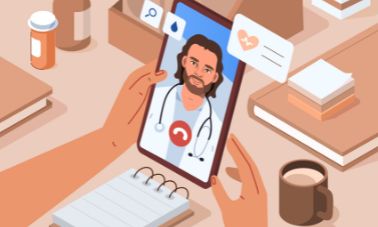Asynchronous telehealth may still be an unfamiliar term to many patients and physicians alike, yet it’s an important subcategory of telehealth, a practice which itself has become increasingly popular even before the onset of the COVID-19 pandemic.
The medical community is currently overworked from both the pandemic and the ripple effect COVID-19 has caused in all aspects of healthcare. Asynchronous telehealth is one approach that benefits both patients and healthcare workers.
How Does Asynchronous Telehealth Work?
Where synchronous telehealth generally refers to patients consulting with physicians via telephone or videoconferencing, asynchronous telehealth goes one step further, by allowing medical personnel to assess their patients’ records at a time other than when the information is gathered.
Asynchronous telehealth has acquired the helpful nickname, “store and forward” because it highlights the process and a significant advantage for physicians. With asynchronous telehealth, you can review and assess the medical records, filled-out questionnaires, or vital signs provided by patients with home devices and respond to the patient or send them along to a specialist for further assessment.
The types of diagnostic tools patients have access and the data they can provide to their medical team has evolved to include more accurate measurements and information synced to their patient records. Through a secure portal, patients or providers can upload lab or imaging results, document symptoms, or provide data from apps and devices that monitor specific vital signs.
Benefits of Asynchronous Telehealth
There are several advantages that asynchronous telehealth brings to the new age of medicine. Here are just a few:
Reduces Infection Spread
Patients and medical staff alike are leery of being exposed to pathogens, especially in the age of COVID-19. While telehealth has long been available on some level for vulnerable patients, the data provided by these video calls was imperfect.
Now, doctors can monitor potentially infectious people without endangering themselves or other patients by monitoring them from home, rather than in the office. Of course, this goes two ways, and patients can also be protected from infectious illnesses by staying home for their visit.
Speeds up Treatment
The traditional healthcare model once centered around a patient visiting their primary care physician with a complaint, getting a referral for additional tests, then returning for a second appointment to discuss the results.
With asynchronous telehealth, however, physicians can have diagnostic tools at the ready, prior to consulting with a patient. They can also quickly schedule appointments based on changes in patients with chronic conditions.
Improves Communication
Whether there is a language barrier between doctor and patient, or the patient simply feels unable to articulate their concerns, traditional medicine can sometimes let down the people most in need of health care.
But technology available through asynchronous programs and other types of telehealth can help translate patients’ responses, as well as provide the non-anecdotal information available through diagnostic tests.
Widens Patient Options
When patients move they often have to make difficult decisions about finding new health care providers. But with telehealth tools, patients can continue to consult with their primary physicians and specialists, if they prefer, and if their physicians are licensed in their new state of residence.
In addition, if a patient wishes to switch doctors when they travel or move, they can provide up to date information about their health more quickly via secure portals.
Increases Practice Efficiency
In the traditional model, a physician wishing to monitor a patient’s progress would need to either wait for their next appointment, or to ask their team to call the patient. But asynchronous telehealth options allow doctors to do this monitoring more frequently and at times that fit into their own schedules.
Those saved minutes add up over the course of days and weeks—which ultimately benefits both patients and their medical team. For patients, it also adds up in terms of savings. A typical fee for an asynchronous monitoring session (perhaps involving an exchange via text or email) is much less than an office or video visit.
Examples of Asynchronous Telehealth
While the term asynchronous health might seem brand-new to some of your patients, chances are your practice is already implementing at least one version of it.
Store & Forward
As mentioned, asynchronous health can be useful for forwarding lab and imaging tests that a doctor reviews at a predetermined time. This might be when all the tests they ordered have been completed, or if they’re monitoring a patient on a weekly, monthly, or other predetermined basis. In these cases, the patient might also have forwarded data such as blood glucose, heart rate, weight, blood pressure, or pulse oximeter, from home medical devices.
AI Chats
If a patient hasn't been to a certain clinic or specialist before, they may be asked to interact with an online chatbot or questionnaire first. While this might seem annoying to some patients, these AI intake tools provide valuable information for the healthcare professionals who will eventually be seeing that patient.
Texting
Even newer options enable doctors and patients to interact via established texting systems that allow for secure, discrete communication. These types of asynchronous health systems work well because they allow the patient to access diagnoses and treatment advice from home, saving time for both the patient and the medical staff.
Get Started with Asynchronous Telehealth
Asynchronous processes with telehealth streamlines complex communication between patients, specialists, labs, and yourself. The ViTel Health platform helps you optimize your time as a physician to provide better care, see more patients, and grow your business—whether telehealth is part of your clinic or your physician side hustle.
Contact us with additional questions or to schedule a demo.



